How To Treat a Hoya Plant
Hoya plants, also known as wax plants, are popular houseplants known for their waxy foliage and fragrant star-shaped flowers.","completion":" they are generally easy to for, hoya plants can encounter several common problems. Here are 7 of the most common hoya plant problems and how to solve them:
Overwatering is one of the most common issues with hoya plants. Hoyas prefer their soil to dry out between waterings. If the soil stays constantly wet, it can cause root rot and other fungal diseases.
Signs of Overwatering
- Leaves turning yellow or brown
- Soft, mushy leaves
- Stems becoming brown and mushy
- Roots that are dark brown or black
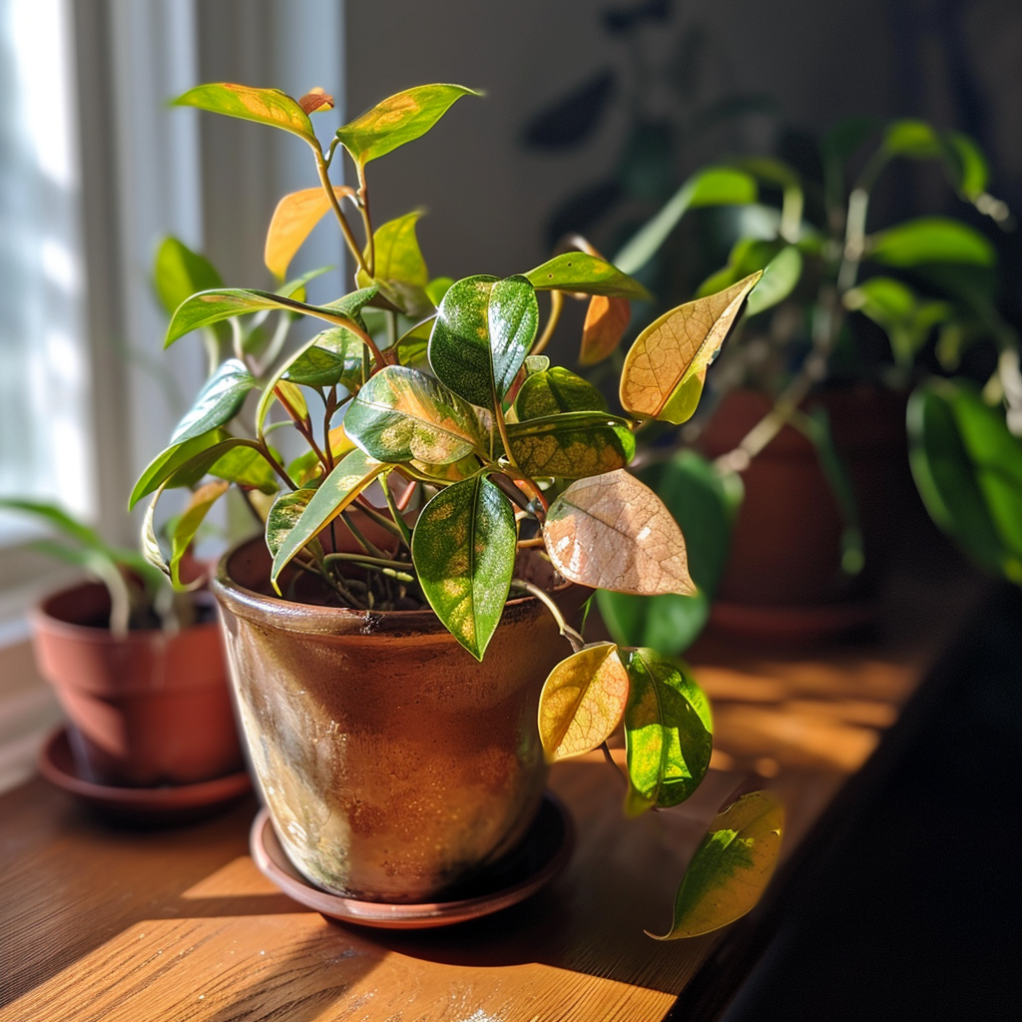
How to Fix Overwatering
- Allow the soil to completely dry out before watering again. Check the soil moisture with your finger.
- Water less frequently, only when the top few inches of soil are dry.
- Improve drainage by repotting in a planter with drainage holes using an airier potting mix.
Prevention
- Water only when the topsoil is dry to the touch.
- Use well-draining soil and a pot with drainage holes.
- Allow excess water to drain out after watering.
While hoyas don't like wet feet, they also don't tolerate completely dry soil for extended periods. Underwatering stresses the plant and can cause leaf drop.
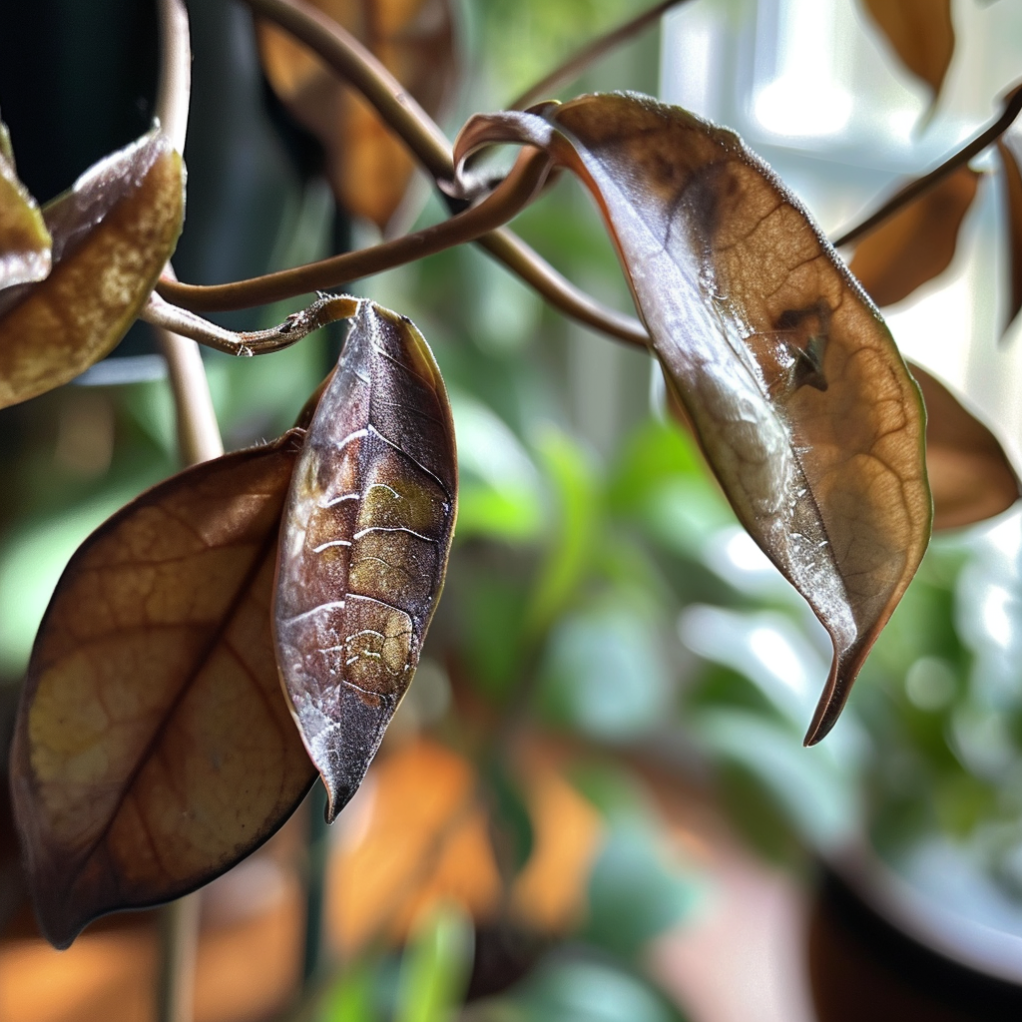
Signs of Underwatering
- Wilting or drooping leaves that don't bounce back after watering
- Brown crispy leaf edges
- Leaf drop
How to Fix Underwatering
- Give the plant a thorough, deep watering until water drains from the bottom of the pot.
- Check the soil moisture more frequently, water when the top few inches become dry.
- Mist leaves occasionally to increase humidity.
Prevention
- Water when the topsoil becomes dry to the touch.
- Check soil frequently, especially in hot or dry conditions.
- Use moisture-retentive soil to avoid drying out too quickly.
Hoyas thrive in humid conditions. Dry air can quickly dehydrate and damage their fleshy leaves. Low humidity causes brown crispy leaf edges.
Signs of Low Humidity
- Leaves curling or wrinkling
- Brown crispy edges on leaves
- Leaves feeling dry or brittle
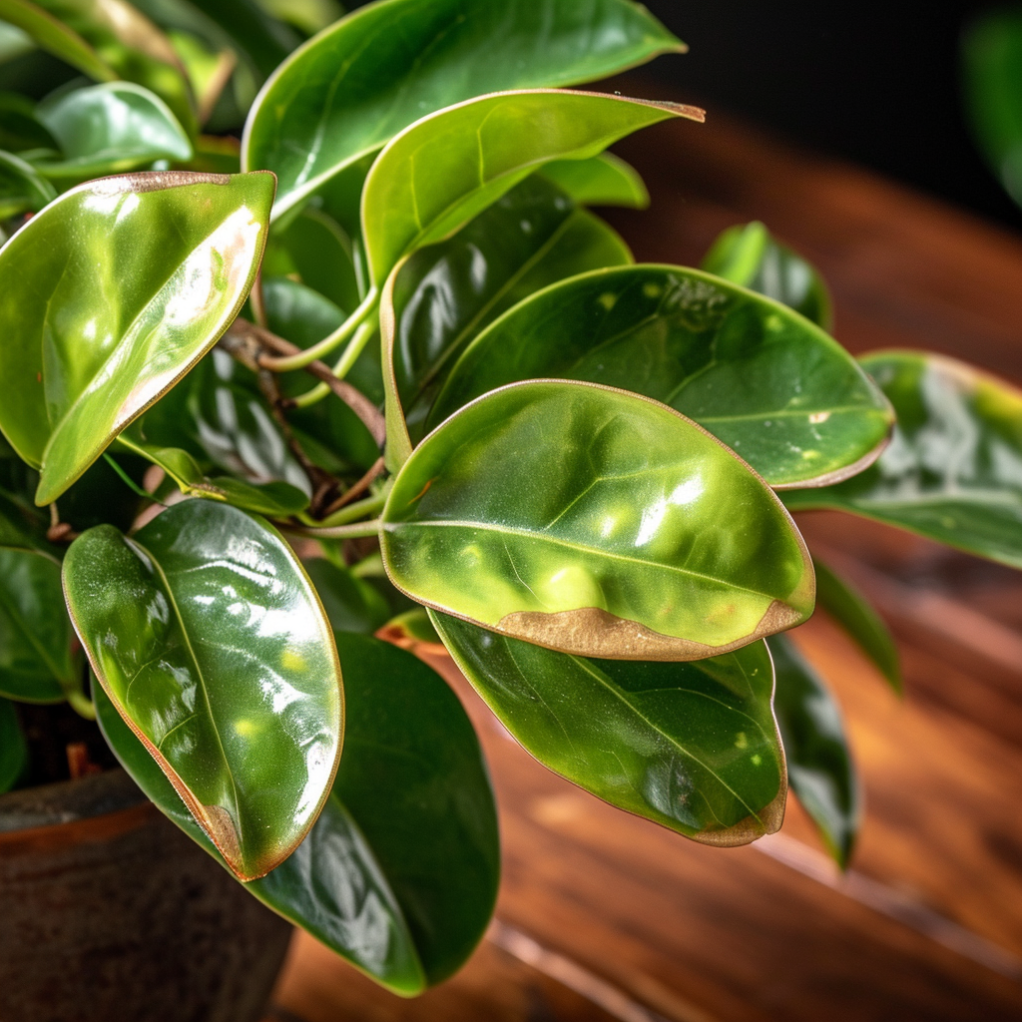
How to Increase Humidity
- Mist leaves frequently with a spray bottle.
- Use a pebble tray filled with water.
- Run a humidifier nearby.
- Grow in a bathroom or kitchen where humidity levels are higher.
Prevention
- Keep on tray filled with pebbles and water to increase local humidity.
- Mist leaves every few days.
- Grow Hoya in bathroom or kitchen if possible.
Too much direct sun can scorch hoya leaves, causing sunburn damage. Hoyas grow best in bright, indirect light.
Signs of Sunburn
- Yellow or whitish discoloration on leaves
- Leaves turning brown or black
- Dry, shriveled leaves
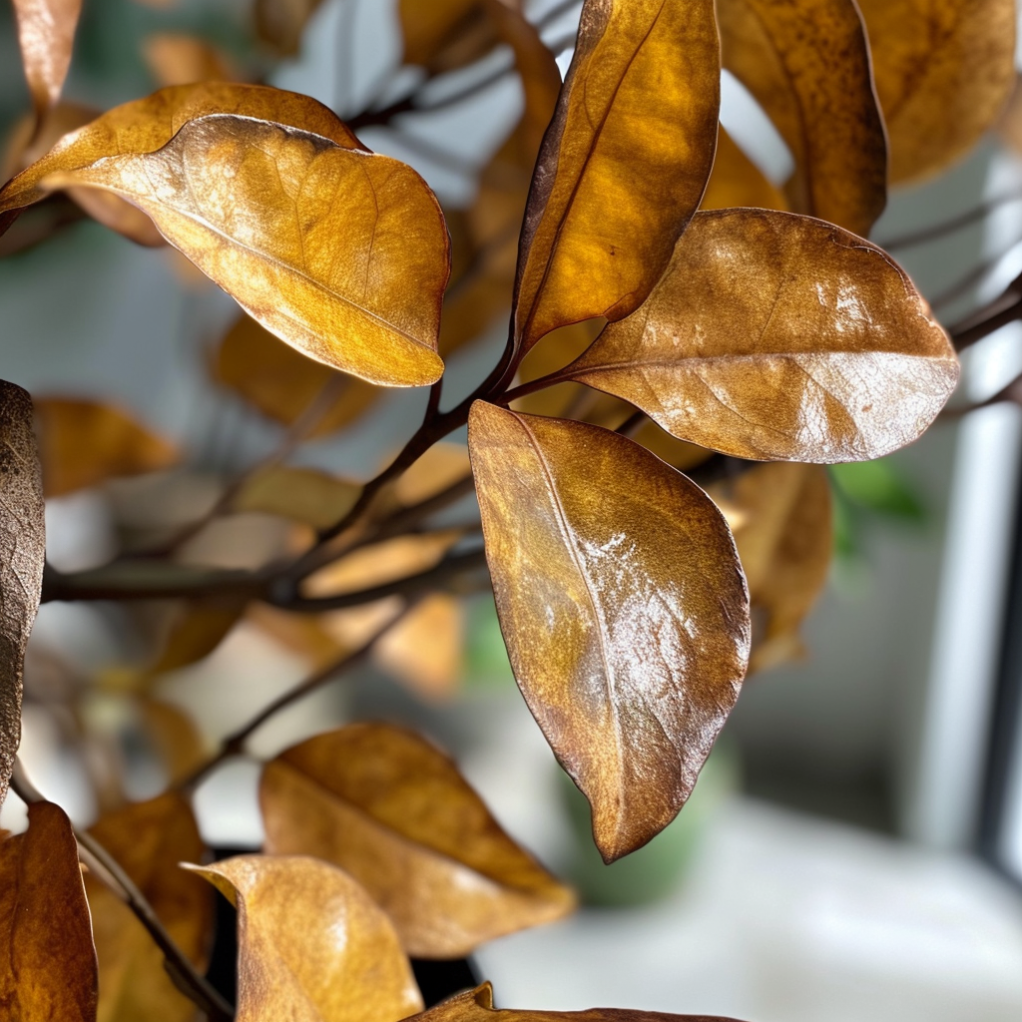
How to Treat Sunburn
- Move plant to a shadier location out of direct sunlight.
- Apply a light shade if unable to move the plant.
- Cut off badly damaged leaves to improve appearance.
Prevention
- Place hoya in bright, indirect sunlight. Avoid direct sun.
- Slowly acclimate to increase light levels to prevent burning.
- Use sheer curtains or shade to filter harsh sunlight.
Hoya plants species are the most sought after by aroid plant lovers
Hoya plants can fall victim to common houseplant pests like mealybugs, aphids, spider mites, and thrips. These sap-sucking insects cause stippling, discoloration, and leaf drop.
Signs of Pests
- Sticky honeydew on leaves
- White cottony clusters on stems or undersides of leaves
- Small insects visible on leaves and stems
- Stippling, spots, or discolored areas on leaves
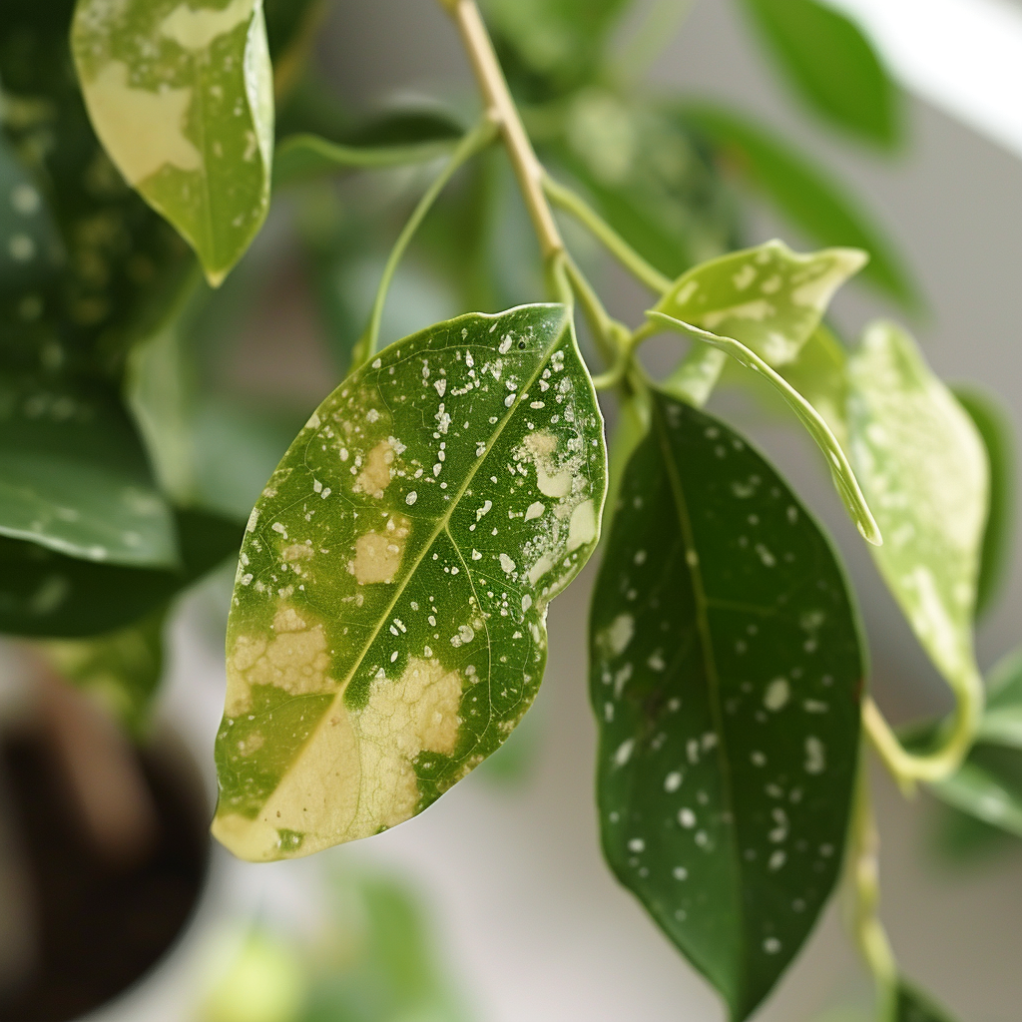
Unleash Nature's Beauty – Explore Our Hoya Varieties!
How to Treat Pests
- Remove bugs by hand or by spraying leaves down with water.
- Apply insecticidal soap spray to kill bugs.
- Treat with neem oil or horticultural oils to suffocate pests.
- Apply systemic granules to the soil to kill pests from the roots up.
Prevention
- Inspect plants regularly for early signs of pests.
- Keep plants healthy to resist infestations.
- Quarantine new plants before introducing.
- Apply horticultural oils or neem oil periodically as a preventative.
Overwatering and high humidity can lead to fungal or bacterial diseases like root rot, leaf spot, and bacterial blight. These are caused by pathogens in wet conditions.
Signs of Disease
- Soft, mushy leaves or stems
- Black or brown spots on leaves
- White fuzzy mold on leaves or soil
- Foul odor from rotten roots or leaves
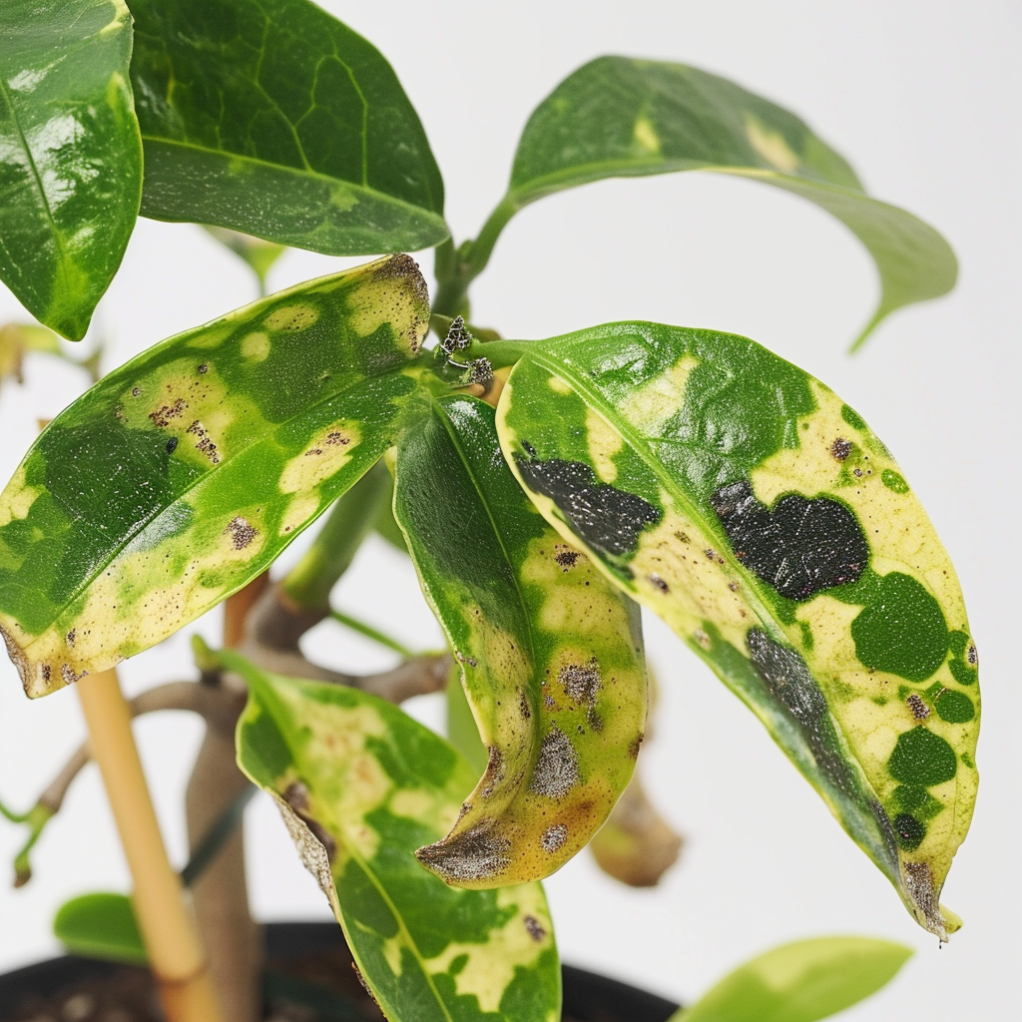
How to Treat Disease
- Improve air circulation and reduce humidity.
- Remove affected leaves and treat with fungicide.
- Repot with fresh sterile potting mix if root rot is present.
Prevention
- Allow soil to dry adequately between waterings.
- Provide good airflow and space plants apart.
- Sanitize tools and pots to prevent spreading disease.
- Avoid overwatering and improve drainage.
Hoyas are fairly fast growing when happy but growth can stall for a variety of reasons like insufficient light, low temperatures, or root bound plants.
Signs of Slow Growth
- Very few new leaves produced
- Smaller leaf size
- Leggy growth from reaching for light
- Lack of new vines or trailing growth
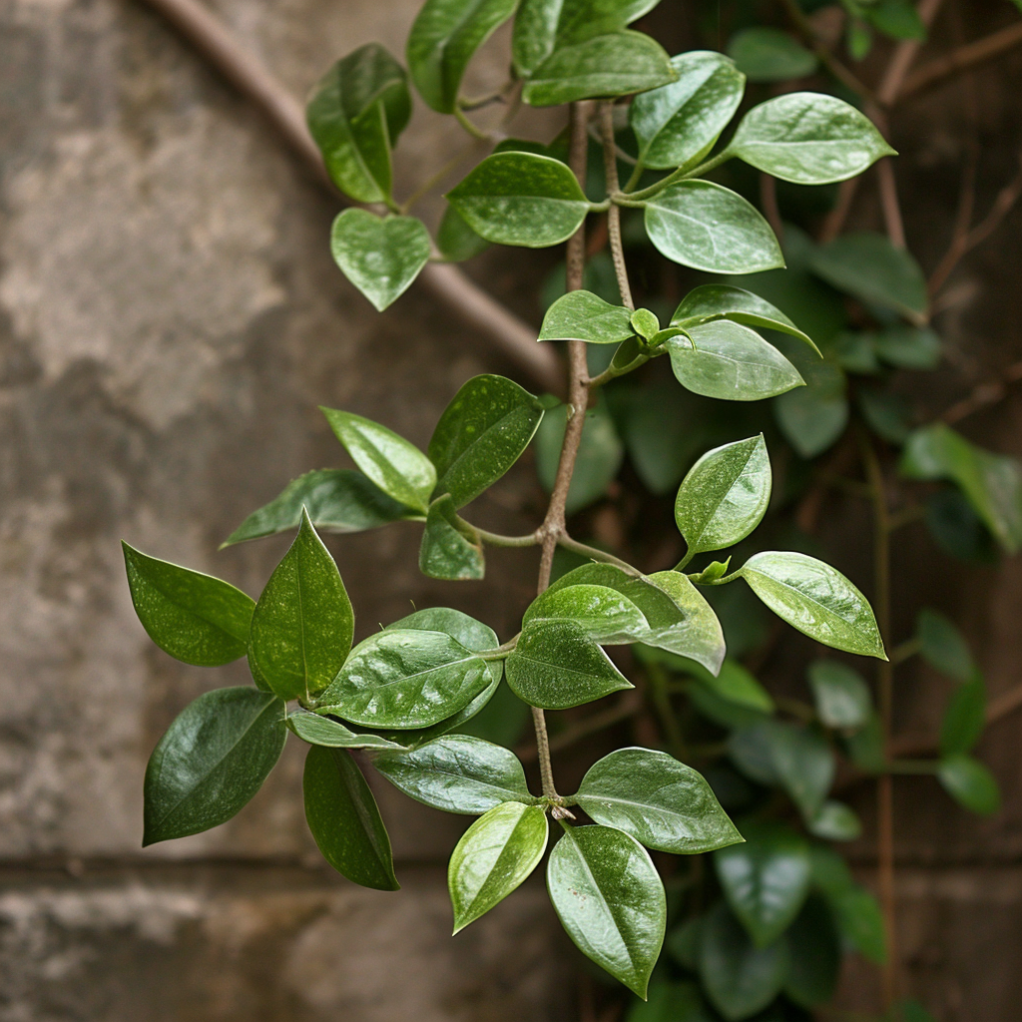
How to Improve Growth
- Move plant to a brighter location.
- Increase daylight hours with grow lights.
- Repot into larger container if root bound.
- Fertilize monthly during growing season.
- Ensure temperatures are warm, around 70-80°F.
Prevention
- Provide very bright, indirect sunlight.
- Maintain warm temperatures year round.
- Water and fertilize regularly during growing periods.
- Repot every 2-3 years as plant grows bigger.
Epipremnum, Philodendron, and Monstera are other plants that benefit from similar conditions and care as Hoya plants.
While hoya plants are relatively easy care houseplants, they can encounter several common problems like overwatering, pests, and insufficient humidity. Paying close attention to their care needs and environment can help avoid many issues. Catch problems early and make adjustments to get your hoya thriving again. With the right care, hoyas make beautiful and blooming houseplants.
- How often should I water my Hoya plant?
- You should water your Hoya plant when the top inch of the soil feels dry to the touch. Typically, this means watering every 2-3 weeks, but it may vary depending on the conditions in your home.
- What type of light does a Hoya plant need?
- Hoyas thrive in bright, indirect sunlight. They can tolerate some direct morning or late afternoon sun, but avoid harsh midday sunlight, as it can scorch their leaves.
- How do I propagate my Hoya plant?
- You can propagate Hoyas through stem cuttings. Simply cut a healthy stem with a few leaves, allow it to callus for a day or two, and then plant it in well-draining soil. Keep it lightly moist until it establishes roots.
- What is the best soil mix for Hoya plants?
- A well-draining potting mix is essential for Hoyas. A mix of potting soil, perlite, and orchid bark or coco coir works well. This helps prevent overwatering and root rot.
- Do Hoya plants require any special humidity levels?
- Hoya plants can tolerate average indoor humidity, but they appreciate a bit of extra humidity. You can mist their leaves or place a tray with water and pebbles nearby to increase humidity, especially during the dry winter months.
See more How to Grow Hoya Plants in 5 Easy Steps
https://greenboog.com/common-hoya-plant-problems-solutions/
Overwatering
Overwatering is one of the most common issues with hoya plants. Hoyas prefer their soil to dry out between waterings. If the soil stays constantly wet, it can cause root rot and other fungal diseases.
Signs of Overwatering
- Leaves turning yellow or brown
- Soft, mushy leaves
- Stems becoming brown and mushy
- Roots that are dark brown or black

How to Fix Overwatering
- Allow the soil to completely dry out before watering again. Check the soil moisture with your finger.
- Water less frequently, only when the top few inches of soil are dry.
- Improve drainage by repotting in a planter with drainage holes using an airier potting mix.
Prevention
- Water only when the topsoil is dry to the touch.
- Use well-draining soil and a pot with drainage holes.
- Allow excess water to drain out after watering.
Underwatering
While hoyas don't like wet feet, they also don't tolerate completely dry soil for extended periods. Underwatering stresses the plant and can cause leaf drop.

Signs of Underwatering
- Wilting or drooping leaves that don't bounce back after watering
- Brown crispy leaf edges
- Leaf drop
How to Fix Underwatering
- Give the plant a thorough, deep watering until water drains from the bottom of the pot.
- Check the soil moisture more frequently, water when the top few inches become dry.
- Mist leaves occasionally to increase humidity.
Prevention
- Water when the topsoil becomes dry to the touch.
- Check soil frequently, especially in hot or dry conditions.
- Use moisture-retentive soil to avoid drying out too quickly.
Low Humidity
Hoyas thrive in humid conditions. Dry air can quickly dehydrate and damage their fleshy leaves. Low humidity causes brown crispy leaf edges.
Signs of Low Humidity
- Leaves curling or wrinkling
- Brown crispy edges on leaves
- Leaves feeling dry or brittle

How to Increase Humidity
- Mist leaves frequently with a spray bottle.
- Use a pebble tray filled with water.
- Run a humidifier nearby.
- Grow in a bathroom or kitchen where humidity levels are higher.
Prevention
- Keep on tray filled with pebbles and water to increase local humidity.
- Mist leaves every few days.
- Grow Hoya in bathroom or kitchen if possible.
Sunburn
Too much direct sun can scorch hoya leaves, causing sunburn damage. Hoyas grow best in bright, indirect light.
Signs of Sunburn
- Yellow or whitish discoloration on leaves
- Leaves turning brown or black
- Dry, shriveled leaves

How to Treat Sunburn
- Move plant to a shadier location out of direct sunlight.
- Apply a light shade if unable to move the plant.
- Cut off badly damaged leaves to improve appearance.
Prevention
- Place hoya in bright, indirect sunlight. Avoid direct sun.
- Slowly acclimate to increase light levels to prevent burning.
- Use sheer curtains or shade to filter harsh sunlight.
Hoya plants species are the most sought after by aroid plant lovers
Pests
Hoya plants can fall victim to common houseplant pests like mealybugs, aphids, spider mites, and thrips. These sap-sucking insects cause stippling, discoloration, and leaf drop.
Signs of Pests
- Sticky honeydew on leaves
- White cottony clusters on stems or undersides of leaves
- Small insects visible on leaves and stems
- Stippling, spots, or discolored areas on leaves

Unleash Nature's Beauty – Explore Our Hoya Varieties!
How to Treat Pests
- Remove bugs by hand or by spraying leaves down with water.
- Apply insecticidal soap spray to kill bugs.
- Treat with neem oil or horticultural oils to suffocate pests.
- Apply systemic granules to the soil to kill pests from the roots up.
Prevention
- Inspect plants regularly for early signs of pests.
- Keep plants healthy to resist infestations.
- Quarantine new plants before introducing.
- Apply horticultural oils or neem oil periodically as a preventative.
Fungal & Bacterial Diseases
Overwatering and high humidity can lead to fungal or bacterial diseases like root rot, leaf spot, and bacterial blight. These are caused by pathogens in wet conditions.
Signs of Disease
- Soft, mushy leaves or stems
- Black or brown spots on leaves
- White fuzzy mold on leaves or soil
- Foul odor from rotten roots or leaves

How to Treat Disease
- Improve air circulation and reduce humidity.
- Remove affected leaves and treat with fungicide.
- Repot with fresh sterile potting mix if root rot is present.
Prevention
- Allow soil to dry adequately between waterings.
- Provide good airflow and space plants apart.
- Sanitize tools and pots to prevent spreading disease.
- Avoid overwatering and improve drainage.
Slow Growth
Hoyas are fairly fast growing when happy but growth can stall for a variety of reasons like insufficient light, low temperatures, or root bound plants.
Signs of Slow Growth
- Very few new leaves produced
- Smaller leaf size
- Leggy growth from reaching for light
- Lack of new vines or trailing growth

How to Improve Growth
- Move plant to a brighter location.
- Increase daylight hours with grow lights.
- Repot into larger container if root bound.
- Fertilize monthly during growing season.
- Ensure temperatures are warm, around 70-80°F.
Prevention
- Provide very bright, indirect sunlight.
- Maintain warm temperatures year round.
- Water and fertilize regularly during growing periods.
- Repot every 2-3 years as plant grows bigger.
Epipremnum, Philodendron, and Monstera are other plants that benefit from similar conditions and care as Hoya plants.
Conclusion
While hoya plants are relatively easy care houseplants, they can encounter several common problems like overwatering, pests, and insufficient humidity. Paying close attention to their care needs and environment can help avoid many issues. Catch problems early and make adjustments to get your hoya thriving again. With the right care, hoyas make beautiful and blooming houseplants.
FAQ
- How often should I water my Hoya plant?
- You should water your Hoya plant when the top inch of the soil feels dry to the touch. Typically, this means watering every 2-3 weeks, but it may vary depending on the conditions in your home.
- What type of light does a Hoya plant need?
- Hoyas thrive in bright, indirect sunlight. They can tolerate some direct morning or late afternoon sun, but avoid harsh midday sunlight, as it can scorch their leaves.
- How do I propagate my Hoya plant?
- You can propagate Hoyas through stem cuttings. Simply cut a healthy stem with a few leaves, allow it to callus for a day or two, and then plant it in well-draining soil. Keep it lightly moist until it establishes roots.
- What is the best soil mix for Hoya plants?
- A well-draining potting mix is essential for Hoyas. A mix of potting soil, perlite, and orchid bark or coco coir works well. This helps prevent overwatering and root rot.
- Do Hoya plants require any special humidity levels?
- Hoya plants can tolerate average indoor humidity, but they appreciate a bit of extra humidity. You can mist their leaves or place a tray with water and pebbles nearby to increase humidity, especially during the dry winter months.
See more How to Grow Hoya Plants in 5 Easy Steps
https://greenboog.com/common-hoya-plant-problems-solutions/
Nhận xét
Đăng nhận xét